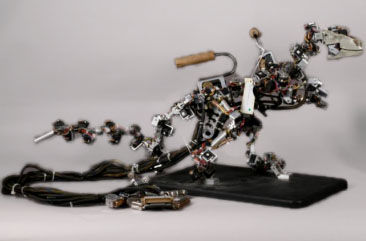“Life finds a way.” This movie quote is a favorite of mine, and it comes from the 1993 Steven Spielberg blockbuster Jurassic Park. I recently learned about the connection between stop motion animation and the frighteningly real dinosaurs in the film, and this quote somehow seems applicable to stop motion as a method in itself. Nearly as old as cinema itself, stop motion continues to be an evolving and dynamic form of filmmaking today. Stop motion has “found a way” so to speak of remaining relevant and interesting in an age of enormous digital capacity.
Stop motion animation has been used in a variety of ways in American filmmaking. For many decades, stop motion was a popular choice for creating special effects for live-action films. Ray Harryhausen, often regarded as the luminary of stop motion animation, used the technique to create some of the most memorable and magical moments in American cinematic effects, including the creature in It Came from Beneath the Sea and the celebrated skeleton warrior sword fight in Jason and the Argonauts.
Director and Visual Effects producer Phil Tippet was greatly inspired by the work of Harryhausen, and developed his own brand of stop motion known as “go motion.” Used to great effect in films such as The Empire Strikes Back, go motion provides a slightly smoother, more realistic movement style than traditional stop motion by photographing objects while in motion.
 A replica AT-AT Imperial Walker model can be seen in the special exhibition Between Frames: the Magic Behind Stop Motion Animation at The Walt Disney Family Museum through April 2013.
A replica AT-AT Imperial Walker model can be seen in the special exhibition Between Frames: the Magic Behind Stop Motion Animation at The Walt Disney Family Museum through April 2013.
Today, stop motion animation is no longer the preferred technique for creating special effects. Filmmakers have since turned to Computer Generated Images, or CGI, to create the fantastical beasts for which stop motion was once responsible.
The turning point when the use of CGI all but eliminated stop motion effects came in the early 1990s, when Phil Tippet was hired for the production of Steven Spielberg’s ambitious project Jurassic Park. Phil Tippet was the obvious choice to develop the visual effects for the film as he specialized in bringing dinosaurs to life on screen. In 1984 he had produced a short experimental film called Prehistoric Beast featuring a realistic –looking stop motion Tyrannosaurus hunting a Monoclonius. The ten minute film only saw a limited release but led to Tippett being hired to develop the dinosaurs for a full-length television documentary for CBS. The program, entitled Dinosaur!, aired in 1985, and earned an Emmy for Outstanding Special Visual Effects.
When Tippet was signed on to produce visual effects for Spielberg’s Jurassic Park, the original plan for creating the terrifying dinosaurs was to bring them to life through stop motion. However, a CGI Team at Industrial Light and Magic created test footage of dinosaurs using computer animation. Spielberg realized that the new method would be successful, and chose to use CGI.
 Though Tippet feared his method had become obsolete, his experience and expertise in creating life-like and frighteningly realistic dinosaurs proved invaluable to the production. Tippet and his team, most notably including designer and model maker Craig Hayes, designed what is known as a Digital Input Device, or DID. The device was virtually an armature of a stop motion dinosaur complete with sensors and electronic input components for capturing the armature’s movements in a computer. A stop motion animator would manipulate the model dinosaur, and its movements would be captured by computer software that would read the movements from the motion sensors and translate them into a three-dimensional model. Computer graphics would then flesh out the model and fully animate the dinosaur.
Though Tippet feared his method had become obsolete, his experience and expertise in creating life-like and frighteningly realistic dinosaurs proved invaluable to the production. Tippet and his team, most notably including designer and model maker Craig Hayes, designed what is known as a Digital Input Device, or DID. The device was virtually an armature of a stop motion dinosaur complete with sensors and electronic input components for capturing the armature’s movements in a computer. A stop motion animator would manipulate the model dinosaur, and its movements would be captured by computer software that would read the movements from the motion sensors and translate them into a three-dimensional model. Computer graphics would then flesh out the model and fully animate the dinosaur.
A DID velociraptor model used for the production of Jurassic Park can also be seen in the special exhibition.
Tippet’s work on Jurassic Park earned him an Academy Award for Visual Effects. Ironically, the film also immortalized Tippet’s own fear of becoming obsolete. When Tippet first learned that stop motion had been replaced by CGI, he exclaimed “I’ve just become extinct!” A memorable scene in the film features scientists discussing the possibility that their own work was becoming, using Tippet’s word, “extinct.”
Though the early 1990s saw the virtual elimination of stop motion as a method of special effects, the animation technique is far from extinct. In fact, stop motion has witnessed what some call a renaissance, particularly in feature films and television series. Though computer animation and graphics might seem to threaten the art of stop motion, the rough, idiosyncratic aesthetic of stop motion animation cannot be captured in other forms of animation or special effects, and for this reason has a strong, sometimes cult-like following. Stop motion animation is completely handmade and captures the distinct touch of each animator. The characters created are often very memorable due to their otherworldly appearance and distinct movement styles.
 Tim Burton’s Nightmare Before Christmas was the first American stop motion feature film to become an indisputable box office success. Directed by Henry Selick and financed by Disney, the film enjoys a distinct following today, nearly twenty years after its original release. Stop motion characters from the film as well as from the 2009 feature Coraline can also be seen in the exhibit.
Tim Burton’s Nightmare Before Christmas was the first American stop motion feature film to become an indisputable box office success. Directed by Henry Selick and financed by Disney, the film enjoys a distinct following today, nearly twenty years after its original release. Stop motion characters from the film as well as from the 2009 feature Coraline can also be seen in the exhibit.
Stop motion features currently have a strong presence among American animated films. Recent stop motion feature releases include Laika’s ParaNorman and Tim Burton’s Frankenweenie.
Stop motion is well represented in television as well. February 2005 saw the debut of the stop motion series Robot Chicken on Adult Swim. The series is now in its sixth season, and is the only program in the history of American television to approach the success and cult-like popularity of the 1950’s cultural icon Gumby.
Nowhere does stop motion feel less extinct than at The Walt Disney Family Museum. The method and rich history of stop motion feels fresh and exciting, as if its legacy is being lived out right here. Check our calendar for upcoming discussions and studio activities based around the Between Frames exhibition.

Alyssa Carnahan
Open Studio Coordinator

